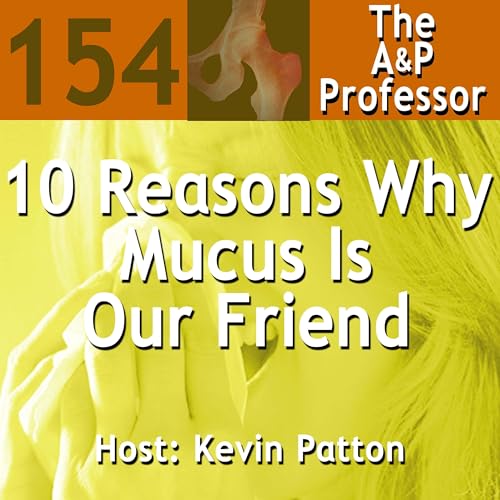Murray Jensen joins Kevin Patton to explore dual enrollment in anatomy & physiology. From guided inquiry to the power of teacher communities, this conversation reveals why messy classrooms often yield the best results. 00:00 | Introduction 00:48 | Murray Jensen, HAPS President's Medal Laureate 02:27 | What Is Dual Enrollment, Anyway? 11:44 | Two-Word Check-In* 12:53 | Guided Inquiry, Not Guided Napping 25:51 | Concept Echo* 26:37 | No, Not Nightly Recorded Lectures 31:09 | Rigor Reality Check* 32:11 | Rigor, Range, & Real Talk 39:25 | Respect Reframe* 40:02 | Why It Matters: Heart, Head, & High School 47:55 | Slide Diet* 49:06 | Money, Mission, & a Playbook for Best Practices 54:04 | Staying Connected * Breaks ★ If you cannot see or activate the audio player, go to: theAPprofessor.org/podcast-episode-155.html ❓ Please take the anonymous survey: theAPprofessor.org/survey ☝️ Questions & Feedback: 1-833-LION-DEN (1-833-546-6336) ✔️ Follow The A&P Professor on Twitter, Facebook, Blogger, Substack, or Instagram! @theAPprofessor 📰 Get the once-or-twice-weekly TAPP Science & Education Updates theAPprofessor.org/updates "The classroom remains the most radical space of possibility in the academy." (bell hooks) Murray Jensen, HAPS President's Medal Laureate 1.5 minutes Kevin introduces his guest, Murray Jensen, a Professor of Biology Teaching and Learning at the University of Minnesota. He highlights Murray's research focus on teaching and learning in human anatomy and physiology, his emphasis on POGIL and cooperative learning, and his many awards, including the 2024 HAPS President's Medal. Kevin also notes Murray's warm reputation as a mentor and colleague, framing the conversation as both professional and deeply personal. What is Dual Enrollment, Anyway? 9 minutes Murray explains how dual enrollment works in Minnesota through the College in the Schools program, which currently involves 28 high schools and 1,100 students. He emphasizes the importance of professional development and the community of practice that keeps teachers connected, supported, and inspired. Kevin shares his own experiences with dual enrollment, reflecting on how it shaped his career and outlook as an educator. Guided Inquiry, Not Guided Napping 13 minutes This segment digs into pedagogy. Murray describes his approach to selecting teachers, focusing on passion and spark, and how he encourages them to adopt guided inquiry and cooperative group learning. He shares stories about the challenges of letting go of control in the classroom, and how productive messiness often leads to deeper learning. Kevin adds his own examples, reinforcing that guided inquiry transforms classrooms into vibrant, memorable learning spaces. No, Not Nightly Recorded Lectures 4.5 minutes Murray makes the case against online-only dual enrollment models that rely on recorded lectures. He insists that learning must remain face-to-face to preserve rigor and connection. The conversation turns to the politics of funding and the pressure to push students through college more quickly. Both Kevin and Murray stress that dual enrollment should not be about speed but about helping students grow and make informed choices about their futures. Rigor, Range, & Real Talk 7 minutes Kevin raises the skepticism some faculty hold toward dual enrollment. Murray responds by acknowledging the range of rigor but emphasizing that many high school programs are every bit as challenging—if not more so—than their college equivalents. He reflects on his path into dual enrollment, the importance of maintaining standards, and the need to respect teachers while navigating the politics of education. Why It Matters: Heart, Head, & High School 7.5 minutes Murray shares the personal side of his work, recalling visits to high schools and the deep respect he has for teachers and students alike. He explains how writing curriculum, providing tools, and supporting teachers keeps him motivated. The discussion highlights the passion, respect, and community at the heart of dual enrollment, even as financial pressures loom. Money, Mission, & a Playbook for Best Practices 5 minutes Looking to the future, Murray describes his vision for creating a best practices guide for dual enrollment in anatomy and physiology. He underscores the importance of focusing on core concepts, guided inquiry, and cooperative learning while moving away from passive slide-based teaching. Kevin and Murray agree that active learning consistently outperforms lecture-heavy approaches, especially in entry-level science courses. Links Teaching to Transgress by bell hooks (book) geni.us/TDCa6G Murray Jensen (U of M faculty page) AandP.info/jd1 Human Anatomy & Physiology Society (organization) theAPprofessor.org/haps POGIL Project: Process Oriented Guided Inquiry Learning (organization) pogil.org University of Minnesota College in the Schools Program (program info cce.umn.edu/...
Más
Menos

 58 m
58 m Aug 19 202529 m
Aug 19 202529 m 58 m
58 m 1 h y 25 m
1 h y 25 m 1 h y 6 m
1 h y 6 m
 Jun 30 20241 h y 4 m
Jun 30 20241 h y 4 m
